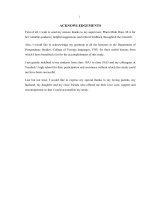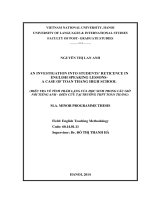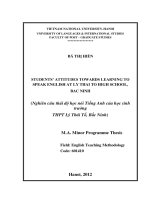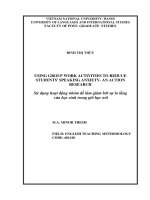Using lexical chunks to support grade 12th students in learning to speak English – Sử dụng cụm từ vựng để hỗ trợ học sinh lớp 12 học nói tiếng Anh – Nghiên cứu
Bạn đang xem bản rút gọn của tài liệu. Xem và tải ngay bản đầy đủ của tài liệu tại đây (739.15 KB, 60 trang )
VIETNAM NATIONAL UNIVERSITY- HANOI
UNIVERSITY OF LANGUAGES & INTERNATIONAL STUDIES
FACULTY OF POST- GRADUATE
BÙI THỊ THANH
USING LEXICAL CHUNKS TO SUPPORT GRADE 12
TH
STUDENTS IN LEARNING TO SPEAK ENGLISH
– A STUDY AT VU TIEN HIGH SCHOOL OF THAI BINH
(Sử dụng cụm từ vựng để hỗ trợ học sinh lớp 12 học nói tiếng Anh -
Nghiên cứu tại trường THPT Vũ Tiên, Thái Bình)
M.A MINOR THESIS
Field: English Teaching Methodology
Code: 601410
Hanoi - 2012
VIETNAM NATIONAL UNIVERSITY- HANOI
UNIVERSITY OF LANGUAGES & INTERNATIONAL STUDIES
FACULTY OF POST- GRADUATE
BÙI THỊ THANH
USING LEXICAL CHUNKS TO SUPPORT GRADE 12
TH
STUDENTS IN LEARNING TO SPEAK ENGLISH
– A STUDY AT VU TIEN HIGH SCHOOL OF THAI BINH
(Sử dụng cụm từ vựng để hỗ trợ học sinh lớp 12 học nói tiếng Anh -
Nghiên cứu tại trường THPT Vũ Tiên, Thái Bình)
M.A MINOR THESIS
Field: English Teaching Methodology
Code: 601410
Supervisor: Dr. Le Van Canh
Hanoi- 2012
iv
TABLE OF CONTENTS
Pages
i
ACKNOWLEDGEMENT
ii
ABSTRACT
iii
TABLE OF CONTENTS
iv
LIST OF TABLES AND FIGURES
v
PART A- INTRODUCTION…………………………………………
1
1. Rationale
1
2. Aims of the study
2
2
4. Method of the study
3
5. Scope of the study.
3
6. Design of the study.
3
PART B. DEVELOPMENT……………………………………………
4
CHAPTER I: THEORETICAL BACKGROUND…………………
4
1.1 SPEAKING SKILL
4
1.1.1 The importance of speaking.
4
1.1.2 What is involved in speaking a foreign language?
6
1.2 LEXICAL CHUNKS
7
1.2.1 Definition of lexical chunks
7
1.2.2 Classification of lexical chunks.
9
1.2.3 Advantages of using lexical chunks in teaching speaking
12
1.2.3.1 Promoting language fluency
12
1.2.3.2 Enhancing language accuracy
14
1.2.3.3 motivation
15
1.3 Lexical classroom activities
16
v
1.4 Summary
18
CHAPTER II: RESEARCH METHODOLOGY……………………
19
2.1 Action research
19
2.2. Reasons for adopting action research
20
2.3 Research instruments
20
2.4 Research procedure
21
2.5
23
2.6 Summary
23
CHAPTER III: DATA ANALYSIS AND DISCUSSION…………
24
3.1 Results fr- treatment questionnaire
24
3.1.1
speaking lessons
24
3.1.2 Factors prevent students from speaking English in the
classroom.
28
-treatment questionnaire
28
3.2.1 S motivation to learn English when they
are taught lexical chunk
28
3.2.2 S benefits of using lexical chunks
in speaking lessons.
29
3.2.3 S
learning lexical chunks in speaking lessons
33
3.2.4 Smprovement of learning
lexical chunks in speaking lessons
34
3.3 Summary
35
vi
CHAPTER IV: MAJOR FINDINGS AND RECOMMENDATIONS
FOR MORE EFFECTIVE APPLICATION OF LEXICAL
CHUNKS…………………………………………………… …
36
PART C. CONCLUSION……………………………………………….
39
1.
39
2. Implications
39
40
REFERENCES……………………………………………………
41
APPENDICES……………………………………………………………
I
APPENDIX A:PRE- TREATMENT QUESTIONNAIRE
I
APPENDIX B: POST TREATMENT QUESTIONAIRE
III
APPENDIX C: SAMPLE LESSON PLAN
VII
vii
LIST OF TABLES AND CHARTS
1. List of tables
Table 1.s classification of lexical chunks.
10
Table 1. typology of lexical chunks
12
Table 3.1
24
Table 3.2: Factors prevent students from speaking English in the
classroom
27
Table 3.3
being taught lexical chunks
28
Table 3.4: s about the accuracy in speaking lesson
when taught lexical chunks
29
Table 3.5 s about the fluency in speaking lesson
when taught lexical chunks
30
Table 3.6 s about their improvement in speaking
lesson when taught lexical chunks
31
Table 3.7s about the advantage of learning lexical
chunks in understanding English grammar
32
Table 3.8: Common factors affected the effectiveness of lexical
chunks in speaking lessons
33
Table
learning lexical chunks in speaking lessons
34
2. List of charts
Figure 3.1: to learn to speak English
25
Figure 3. 2: toward learning grammar
25
Figure 3.3: s toward learning to speak English.
26
Figure 3.4: s about the accuracy in speaking lesson
when taught lexical chunks
30
viii
Figure 3.5: s about the fluency in speaking lesson
when taught lexical chunks
31
Figure 3. 6: s about their improvement in speaking
lesson when taught lexical chunks.
32
1
PART A: INTRODUCTION
1. Rationale
Acquiring vocabulary is a critical issue to help students develop their
words (1972:111)
vocabulary
Krashen argues that vocabulary plays a fundamental role in verbal
communication
should acquire an adequate number of words and should know how
to use them accurately. If acquirers do not recognize the meaning of
the key words used by those who address them they will be unable
(Krashen, 1983 cited in Lewis, 1993: 23)
He further clarifies that if the stude
communicate effectively no matter how good their grammatical knowledge
might be
addressed to them, but do not know the meaning of key lexical items, they
will be unable to participate in the communication. For this reason, we are not
impressed with approaches that deliberately restrict vocabulary acquisition
(Krashen, 1983
cited in Lewis, 1993: 23)
Three basic elements of a language are phonology, vocabulary and
grammar. In fact, both grammar and phonology are embedded in vocabulary
because we cannot teach vocabulary without teaching the students how to
pronounce the words and how words are put together to make grammatical
sentences. According to Michael Lewis (1993), vocabulary is more than
2
However, EFL teachers
seem to overemphasize learning grammar more than vocabulary in their
teaching. The role of vocabulary has long been underestimated in EFL
education.
Lewis (1993) proposes the Lexical Approach and brings the field to
systematically examine the nature of lexis in second language acquisition.
According to him bulary dichotomy is a false. Often when
present and record the word but to explore the gram
1993: 115). He strongly argues aticalised
lexis, not lexica vi). The pairing of grammar
and vocabulary is best seen in lexical chunks, which are retrieved and
processed as whole units. These units may not only enhance the accuracy and
fluency of the language, but also speed up language processing significantly.
These characteristics of lexical chunks motivate me to experiment using
2. Aims of the study
The thesis is primarily aimed to gain understanding of the extent to
which lexical chunks can motivate and benefit students in their speaking
activities and then give some suggestions for teachers to stimulate students to
speak and overcome the difficulties they face with in using lexical chunks to
teaching speaking skills and some suggestions for the next cycle of the
research on the topic.
3. Research questions
The study was designed to answer the following questions:
(1) To what extent does the use of lexical chunks influence the
speak English as measured by their self-
3
reported changes in their confidence and participation in speaking
English?
(2) What do the students self-report on the benefits of using lexical
chunks to their speaking English in the classroom?
(3) eived difficulties in learning to speak
English with this teaching strategy?
4. Scope of the study
The study is limited to the understanding of the impact of using lexical
scale
action research project, which was undertaken to improve my teaching
practice.
5. Method of the study
A quantitative method was used to gain the aim of this study, which is
exploratory in nature. Data were collected by means of pre- and post
treatment questionnaires. It is noted that the primary aim of the study is to
gain understandings of the extent to which using lexical chunks can support
students in learning to speak English for my teaching practice rather than to
find out the cause and effect relationship between the use of lexical
and post
treatment questionnaires are appropriate for this aim.
6. Design of the Study
The thesis is composed of three following parts:
Part A: Introduction provides the rationale, aims, scopes, method and
design of the study.
Part B: Development- consists of four chapters.
Chapter I: Literature Review: This chapter provides the theoretical
background for the study.
4
Chapter II: Research methodology- Presents research questions, action
research, reasons for adopting action research, research instruments, research
procedure and participants.
Chapter III: Data analysis and discussions - The detailed results of the
survey and a comprehensive analysis on the data collected are focused.
Chapter IV: - This chapter presents the findings and offers
recommendations for more effective application of lexical chunks
Part C: Conclusion: Some limitations of the study, suggestions for
future research and conclusions of the study are presented in this part.
5
PART B: DEVELOPMENT
CHAPTER I: THEORETICAL BACKGROUND
This chapter deals with the theoretical background t I employed for the study
1.1 SPEAKING SKILL
1.1.1 The importance of speaking
According to Byrne (1991), among the four language skills, listening
and reading are considered as the receptive skills, speaking and writing as the
productive skills. They are also divided according to the manners by which
they are formed. The skills in connection with manual script including reading
and writing are called literacy skills. The ones which are related to articulator
organs are called the oral skills consisting of listening and speaking. Of the
four skills, speaking plays a very important role since it is the step to identify
who knows or does not know a language. Anyone who knows a foreign
language can speak that language. Byrne (1991
English in order to be able to speak easily, comfortably, confidently. This is
true for people who need to learn English for work or study, or even for those
who want to learn Spanish or Chinese for travel. Most people want to learn to
Pattison (1992) confirms that when a person speaks of knowing or
learning a language they mean being able to speak the language. Thus,
speaking is a type of linguistic output. By producing the output, learners are
expected to notice the gap in their knowledge and then find ways to bridge the
gap.
Therefore, the importance of speaking in learning a second or foreign
language has been stated by many scholars. For example, Newmark (quoted
from Brumfit C. J. and Johnson K., 1979: 161) gives an example of a person
who wants to smoke but cannot know how to speak to borrow a stranger
6
the teacher, yet cannot know the way to get his cigarette lit by the stranger
you have a
Hence, the aim of teaching speaking skill is to help learners have
communicative efficiency or in other words is to teach learners the way to
give by Newmark of a man who is good at structures but fails in utterance
competence.
Thus, in order to help learners develop communicative efficiency in
speaking, balanced activities approach should be used to combine language
input, structured output and communicative output.
Language input is presented to learners through listening
and reading activities and the language heard and read outside
of class. Language input provides learners with the material to
begin producing language themselves. Language input may be
content oriented or form oriented.
Structured output emphasizes correct form. Basing on the
specific form or structure that the teacher has just introduced,
learners may have options for responses. Structured output is
designed to make learners comfortably producing specific
language items recently introduced, sometimes in combination
with previously learned items.
Communicative output primarily aims to complete a task,
order to complete the task, learners not only use the language
that the teacher has just presented but also draw on any other
7
vocabulary, grammar, and communication strategies that they
know. In communicative output activities, the criterion of
success is whether the learner gets the message across.
Accuracy is not a consideration unless the lack of it interferes
with the message.
In a balance activities approach, the teacher uses a variety of activities
from these different categories of input and output. Learners at all proficiency
levels, including beginners, benefit from this variety, it is more motivating,
and it is also more likely to result in effective language learning.
1.1.2 What is involved in speaking a foreign language?
Speaking was defined as
meaning that involves producing and receiving
(Florez ,1999 cited in Bailey, 2005: 2). It - ended
l utterances to convey
(Balley, 2005:2).
Brown (1994: 258) makes the following list of skills & knowledge that
a good speaker has to possess:
The sounds, stress pattern, rhythmic structures and intonations
of the language
Accurate grammar structures
Vocabulary that is understandable and appropriate for the
audience, the topic being discussed, and the setting in which the
speech act occurs
Strategies to enhance comprehensibility, such as emphasizing
key words rephrasing, checking for comprehension, using gestures
or body language
Gestures or body language
8
Attention to the success of the interaction and adjusting
components of speech
1.2 LEXICAL CHUNKS
1.2.1 The definition of lexical chunks
easy to define it (Weinert,1995:182). In fact, are defined
differently in the literature. They may be (Hakuta,
(Peters, 1983), or - The
diverse definitions of the term show both the significance and the complexity
of this linguistic area.
Nattinger and DeCarrico (1992:1) define the lexical chunks as lexical
phrases. They describe lexical phrases as:
y are multi-word
lexical phenomena that exist somewhere between the traditional
poles of lexicon and syntax, conventionalized have more
idiomatically determined meaning than language that is put
rticular discourse
function, such as expressing time, a month ago, or relationships
among ideas, the higher X, the higher Y.
According to this definition, lexical phrases have not only syntactic
structure, but also functional meanings, such as greeting (how are you?),
expressing summary (all in all or above all), and expressing relationships
among ideas or things (not only_, but also_), expressing time relationship
which makes lexical chunks differ from other conventionalized or frozen
9
Viewing vocabulary as more than words, Lewis (1993) initiates the
term He modifies the connotation of
lexicon from single words to the collocation of many ritualized bits of
language, and explains that lexis is different kinds of multi-word chunks,
produce continuous coherent tex
basis for a lexical view of language and the lexical approach to second
language teaching.
According to (1998:40) definition a lexical chunk is a multi-
word item, which can be referred to otherwise as a vocabulary item consisting
of a sequence of two or more words. This sequence of words semantically
and/or syntactically forms a meaningful
definition focuses on the form of the lexical chunk, and points out that the
form contains its particular meaning as a unit.
Taking a psycholinguistic perspective, Wray (2000) defines lexical
chunks as:
rds or other
meaning elements, which is, or appears to be, prefabricated; that is,
stored and retrieved whole from memory at the time of use, rather
than being subject to generation or analysis by the language
(p. 465).
t a lexical chunk is a ready-made
meaningful linguistic unit that is memorized and operated in use instantly.
help to reduce the cognitive load of the students while speaking English as a
foreign language.
10
As can be seen from this definition, the basic characteristic of the
lexical chunks is fixed or semi-fixed lexical phrases, which can be stored and
retrieved automatically as a whole unit in the process of language acquisition.
Learners do not have to analyze and focus on the individual words of the
phrases, but should pay more attention to the whole chunks. This can facilitate
not only the fluency but also efficiency of the language production.
1.2.2 Classifications of lexical chunks
As there is no generally accepted definition, there is no fixed
classification of chunks in the existing linguistic field. Many linguists bring
forward their own criteria from different perspectives.
Among them, the classifications presented by Nattinger & De Carrico
(1992) and Lewis (1993) seem to be more widely accepted than others. These
classifications are reviewed below.
The classifications given by Nattinger and De Carrico (1992:37-44) are
primarily based on structural criteria.
Table 1.1: Nattinger and DeCarrico’s classification of lexical chunks
Type of lexical chunks
Examples
Poly words:
(1) Polywords are short phrases which
function very much like individual lexical
items (function to express speaker
qualification of the topic at hand, relate one
topic to another, summarize, shift topics
and so on.)
(2) They allow no variability.
(3) They are continuous
For the most part (qualifier)
In a nutshell (summarizer)
By the way (topic shifter)
I’ll say ( agreement marker)
All in all (summarizer)
By and large (qualifier)
Institutional expression:
(1) Institutionalized expressions are lexical
How are you? (greeting)
11
phrases of sentence length, usually
functioning as separate utterances.
(2) They are invariable
(3) They are mostly continuous
Institutionalized expressions are proverbs,
aphorisms, for social interaction. They are
used for quotation, allusion or direct use.
Nice to meet you (closing)
There you go (approval)
Give me a break (objection)
Sentence builders:
(1) Sentence builders are lexical phrases
that provide the framework for whole
sentences.
(2) They contain slots for parameters or
arguments for the expression of entire
ideas.
(3) They allow considerable variation of
phrasal (NP, VP) and clausal (S) elements.
(assertion): I think (that) X
It seems (to) me that X
I think that it’s a good idea
(relators): Not only X but also Y
(summarizer): My point is that X
(request):Modal +you + VP (for me)
Phrasal constraints:
(1) Phrasal constraints are short to
medium length phrases,
(2) They allow variation of lexical and
phrasal categories
(3) They are associated with many
Functions
Temporal relator : a…ago
Topic shifter: as I was saying/
mentioning
Summarizer; in sum, in short
Greeting: dear… (Nam, Mr.)
Closing: yours truly/ sincerely
Qualifier: as far as I know/ can tell
According to Nattinger & De Carrico (1992:44), lexical phrases types
differ in grammatical level, in the kind of substitution they allow, and to
whether they are typically continuous or discontinuous.
12
Lewis (1993:92-95) classifies the lexical chunks into four different
basic types. They are polywords, collocations, institutionalized utterances and
sentence frames and heads.
Table 1.2: Lewis’ typology of lexical chunks
Types of lexical chunks
Examples
Polywords: Extension of words, which is
composed of more than one word. And it is
often considered to be the essential vocabulary
for learners to acquire.
by the way, upside down, as
soon as, on the one hand, talk
about, after all, grow up and so
on
Collocation: refers to pairs of words that
frequently co-occur with each other. These
frequent associations merge into habitual
connection and sometimes they are in a fixed
order.
community service,
absolutely convinced
knife and fork,
bread and butter
play the basket ball
Fixed expressions/Institutionalized utterances:
Chunks that are called whole units and
conventionalized in the language. They tend to
express pragmatic rather than referential
meaning. The chunks may be full sentences,
usable with no variation but always with
instantly identifiable pragmatic meaning.
accepting: I’d be delighted to
offering: can I give you a hand
supposing: If I were you…
I’ll get it; We’ll see;
Inviting: Would you like a cup of
coffee?
Semi-fixed expressions/Sentence frames and
heads: serve as the framework builder of the
whole sentences.
Frames and heads: It is
suggested that…, The fact is…,
My point is that…
Composition frames: firstly,
secondly…, finally…
13
Lewis (1993) claims that the first two categories are concerned mainly
with referential meaning, and the latter two with pragmatic meaning. The two
most important classifications are collocations and institutionalized
expressions. The former one is message-orientated, and the latter one is
pragmatic in character.
As can be seen from the classifications listed above, there is still no
fixed standard for classification of lexical chunks, and researchers set up their
own criteria for their own research aims. However, when we use these
criteria, we must be aware that all of these lexical chunks range between two
extremes from absolutely fixed to highly free. Therefore the categorization is
fuzzily edged, and sometimes it is quite difficult to make specific boundaries
between these types.
1.2.3 Advantages of using lexical chunks in teaching speaking
- y are helpful to L2
learning Scholars have summarized three major benefits of using lexical
accuracy, and motivation. These three benefits are discussed in detail in the
following sections.
1.2.3.1 Promoting language fluency
Fluency in spontaneous connected speech may take the adult learner of
a foreign language years to achieve.
ability to produce language rapidly, coherently, appropriately, creatively as
well as automatically (1998:13). From this definition, fluency not only
involves the speed of the language production but also the logical
organization of the production.









